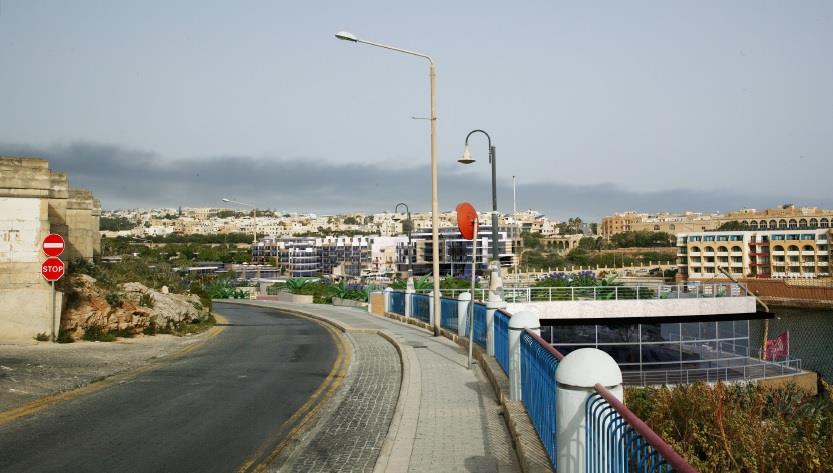The Planning Authority Board has approved a major Villa Rosa-Cresta Quay area development, which will see the construction of parking facilities, hotels and ancillary facilities, commercial areas, multi-ownership holiday accommodation, bungalows and a Language school with accommodation.
The board voted 7 in favour and three against.
The 48,723 sqm redevelopment project, which was filed by Garnet Investments Ltd back in 2012, will be built over different locations around St George's Bay, St Julian's, and includes the "demolition of all existing buildings forming part of St. George's Bay Hotel, Dolphin House, Moynihan House and Cresta Quay",
The Superintendence of Cultural Heritage found that the development does not pose a threat to Villa Rosa and its gardens; and that Moynihan House did not have cultural heritage value.
The plans presented starkly contrast what was suggested in the Paceville Master Plan, in fact, Anton Camilleri - of Garnet Investments Ltd. - had, back then, said that what appeared on the master plan was not in line with his proposal.
Parliamentary representatives Marthese Portelli (PN) and Clayton Bartolo (PL), who voted in favour of the poject, both called for the Paceville master, which was scrapped following criticism that it was more geared towards developers rather than residents, was completed as soon as possible.

PA CEO Johann Buttigieg said that regrettably there was no master plan in place, but the development was following the local plan.
Both Portelli and Bartolo also raised concerns over the negative traffic impact the development will undoubtedly have, both during and after construction; with both of them stressing that the planning gain should be extended to the surrounding localities of Pembroke and Swieiqi.
The former also called for the introduction of a national audit on the country's cultural heritage, while the latter expressed his disappointment that the facade of Moynihan House will not be preserved or incorporated into the design of the building.
Albert Buttigieg raised the serious concerns regarding the social and physical infrastructural issues, along with the piecemeal approach taking place when it comes to development, especially considering that a master plan that was meant to be implemented is currently on the shelf; and that the 32 storey development at Mercury House has already been approved.
When given the floor, the public along with a local councillor from Pembroke, echoed Flimkien Ambjent Ahjar's (FAA) concerns that the development could lead to the irreparable damage of the supposedly protected Ghar Harq Hammiem, Malta's largest underground cave presently believed to be roughly the size of the Mosta dome and dates back to the last ice age.
The proposed 100,000 euro earmarked for the cave's protection should anything happen to it during construction was scoffed at by members of the public, with one person remarking that this amount was nothing compared to the profits the development will yield.
Architect Ruben Sciortino said that the development has conducted comprehensive studies on the area and insisted that no excavation will take place above the cave.

What will the development entail?
The Villa Rosa upper gardens will see the construction of an underground car park and [also underground] catering and sanitary facilities, intended to support the use of Villa Rosa and its grounds for weddings, banquets, and similar events. Villa Rosa itself will be restored and used for weddings, banquets and similar events.
Part of the development is a six-floor building south of Triq -Ix-Xatt Ta San Gorg, adjacent to the Bay Street complex. It will used as a mixed-use development ranging from a boutique hotel, commercial space, offices and will see multi-ownership hotel accommodation apartments built, with dedicated food and beverage space at ground level.
The area in front of the bay will see a 4,247sqm two-storey commercial building utilised.
The valley watercourse area, East of Triq ix-Xatt ta San Gorg, which has a gross floor area of 4,050sqm , is earmarked for a number of two-storey, 3-bedroomed villas with private pools.
According to the Case Officer's report, an area in the Villa Rosa grounds adjacent to Bay Street Complex will also see a total gross floor of 1,435sqm built over three floors for retail and office use.
Dolphin House and Moynihan House will be demolished and redeveloped into commercial space for food & beverage, office space and a language school.
The Cresta Quay zone development involves the development of 2,140sqm footprint of land into a 56-room 4-star hotel including restaurant over four floors below road level, and a kiosk at street level. The layout will allow for the use by the public of a 3m wide strip along the coast, the report read.
A number of concerns were raised by persons who reside in the area, including that the excavation works to make space for the underground car parks is not considered as the preservation of the existing garden, that construction at Cresta Quay runs counter to policy given that it is a coastal area etc.
The Superintendence of Cultural Heritage and the Cultural Heritage Advisory Committee have reviewed the application, having inspected the site. "The proposed works do not pose a threat to the Villa Rosa and its gardens and the Superintendence is favourable to the proposed restoration of the villa."
"In reviewing the application, the Superintendence notes that Moynihan House is not formally scheduled by the Planning Authority. Inspection has confirmed that the property has been subject to later interventions and extensive reconstruction, reducing its cultural heritage value."
The Environment and Resources Authority "predicted a number of potential impacts on the environment as a result of the proposed development especially in the St. George's Bay Hotel site, and the Dolphin House and Moynihan House site"; while also noting the potential adverse cultural, congestion, and infrastructural impacts of the development.
The Case Officer has recommended that the project be approved.